by Federico Giannini (Instagram: @federicogiannini1), published on 22/01/2017
Categories: Exhibition reviews
/ Disclaimer
Review of the exhibition 'Giovanni Dal ponte - Protagonist of Florentine Late Gothic Humanism' in Florence, Galleria dell'Accademia, November 22, 2016 to March 12, 2017
Four and a half years after the Uffizi’s memorable Bagliori Dorati exhibition,late Gothic art is back in the spotlight in an institution of the former Polo Museale Fiorentino, the Galleria dell’Accademia, with an exhibition dedicated to one of the most interesting players of that season: Giovanni di Marco, better known as Giovanni dal Ponte (Florence, 1385 - 1437) because his workshop was located in the square of Santo Stefano al Ponte in Florence. Giovanni dal Ponte. Protagonist of Late Gothic Humanism (this is the title of the exhibition) is certainly a scientifically sound operation: a successful project of high caliber that brings together a large part of the Florentine painter’s production, also making use of important international loans, compares it with works by other painters of the time and displays it in a path that follows the evolutions but also the returns to the past of an imaginative and not very constant painter, who in his youth looks to Gherardo Starnina and then to Ghiberti and Gentile da Fabriano, then is fascinated by the Masaccio revolution, and ends his career by returning to a pleasantly late Gothic art. An important exhibition also because it is the first monographic exhibition dedicated to Giovanni dal Ponte, conceived with the purpose of operating “a critical repositioning of the artist that recognizes his non-secondary role within the side of Late Gothic Humanism, in the footsteps above all of artists such as Lorenzo Ghiberti, Gherardo Starnina, Paolo Uccello, and Masolino da Panicale” (so in the catalog Angelo Tartuferi, curator of the exhibition together with Lorenzo Sbaraglio). There are several novelties: works restored for the occasion, a new chronological proposal for works characterized by Masaccio’s ancestry, a new acquisition for the Galleria dell’Accademia (a Madonna and Child from the church of the Badia Fiorentina but which was kept at the Certosa del Galluzzo).
The exhibition, however, has a major problem, namely the serious shortcomings on the popularization level: that is, it lacks apparatuses to guide a public that is not necessarily an expert in understanding Giovanni dal Ponte’s art. This is a rather important shortcoming if we consider that the exhibition is held in one of the most visited museums in the world (third in Italy and among the top fifty on a planetary level), and that there are many visitors who decide to pass through the exhibition halls before continuing their tour of the museum: the result is that the exhibition, which is certainly niche, is perceived as reserved for specialists or connoisseurs of late Gothic art. What’s more, visitors are “enticed” to visit through powerful installations with a strong scenic impact, conceived by the Guicciardini-Magni Architectural Studio: the entrance to the exhibition, for example, is a reproduction of the main portal of the Basilica of Santa Croce (with the rose window presented, however, as if we were seeing it from the inside), while the works, in the itinerary, are housed within niches carved out of pillars adorned with the decorative motifs of the Cathedral of Santa Maria del Fiore. The scenic layout is impressive (and the works do not suffer from it: except perhaps in one or two cases they are excellently lit and at the right distance from the viewer), but perhaps we would have preferred the exhibition to invest more in the care of the disclosure apparatus. The problem is especially noticeable in the vicinity of the key works, those that best allow us to frame the evolution of Giovanni dal Ponte’s manner: if we consider that at least two of these works are predella compartments (we will discuss this at greater length in a moment), that is, objects to which the general public typically devotes less attention than it does, for example, to the central compartments of a polyptych, the weight of these shortcomings is very easily understood.
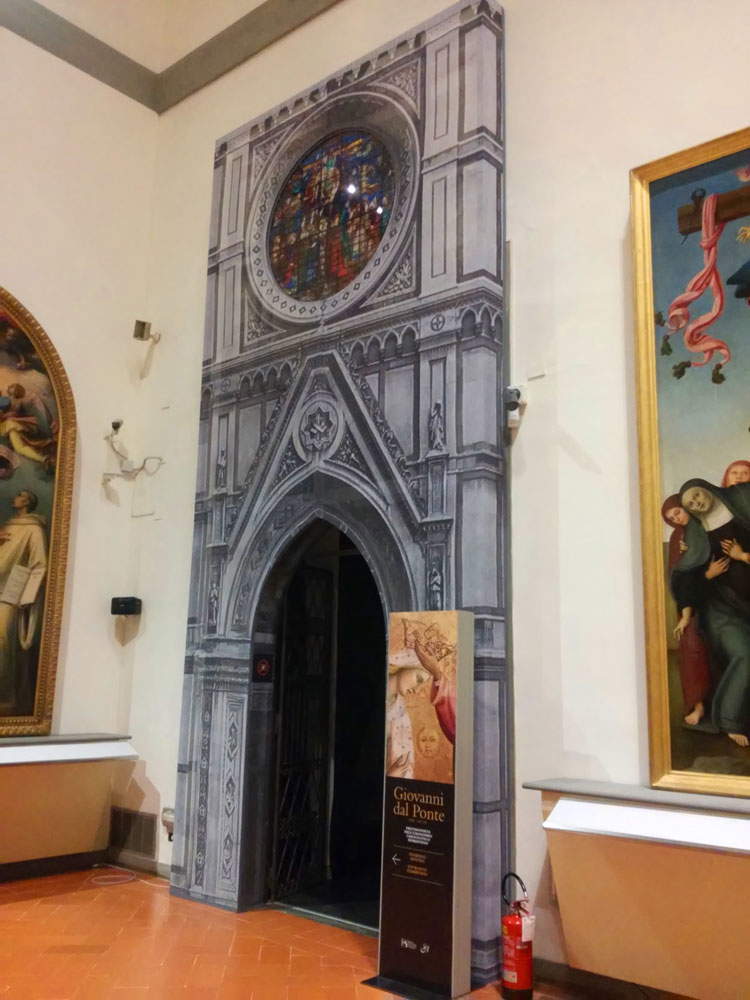 |
| The entrance to the exhibition |
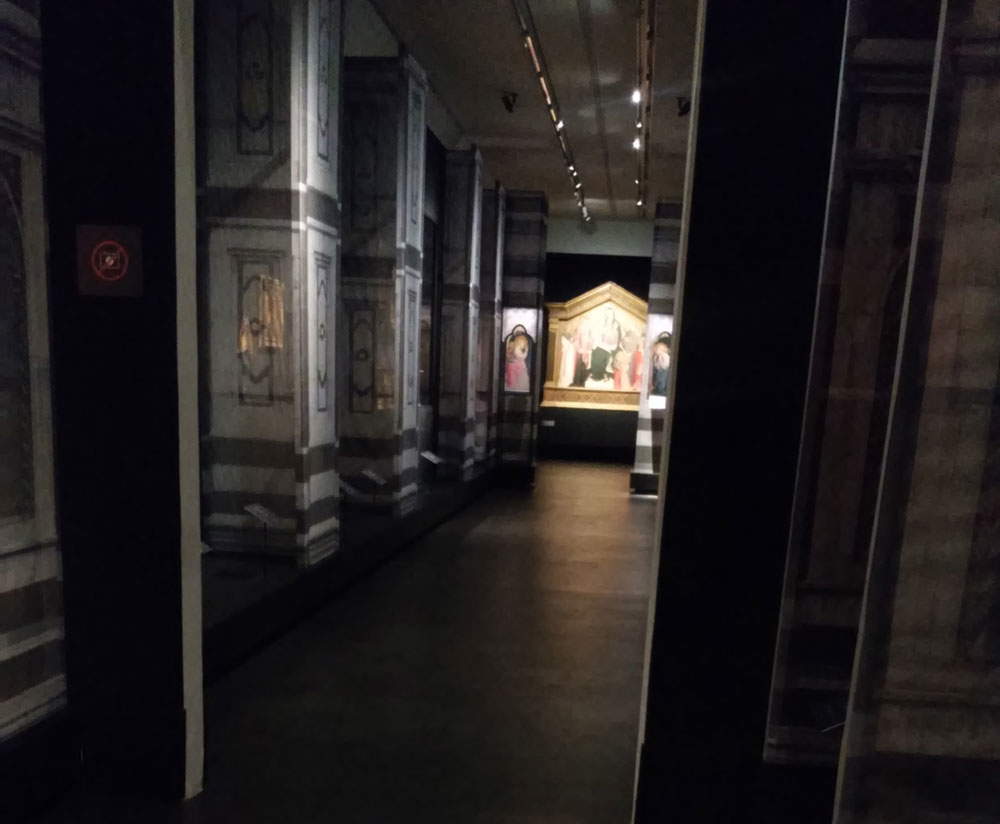 |
| The layout of the exhibition |
The exhibition opens by letting us sample the artistic temperament of the early fifteenth century, in order to frame both the historical context and the hinges on which Giovanni dal Ponte’s art moves. Gherardo Starnina, one of the main points of reference in the early stages of Giovanni dal Ponte’s career, is adequately represented by the Würzburg Triptych. The similarities, however, are to be found in the manners and certain details, rather than on the volumetries: to the firmness of Giottesque imprint of Gherardo Starnina’s triptych, Giovanni dal Ponte seems to prefer more slender figures of essentially Spanish matrix (artists of Iberian origin such as the Portuguese Ãlvaro Pires de Evora and the so-called Master of the Vispo Child were active in early 15th-century Florence, a probably Valencian artist for whom some critics have proposed identification with Miguel Alcañiz, and Starnina himself had stayed for a long time in Spain and once back in Florence updated the local environment based on his own experience). In keeping with Starnina’s style, however, are the great liveliness (also, however, of Iberian origin), the delicacy of the faces (the redness on the faces of the Madonnas of the two is a significant index), the bright chromaticism, and certain details: see, for example, the noses of the characters (straight, Greek profile-like, those of Giovanni dal Ponte) on which a whitish light always spreads, making the septa shine and stand out. Most effective, then, is the comparison between Starnina’s triptych and Giovanni’sCoronation of the Virgin, his only painting in the first room. Also present are Lorenzo Monaco (with two compartments from the San Gaggio polyptych), to whom ours will look for certain formal solutions, Lorenzo Ghiberti (a Blessing Christ from the Hospital of Santa Maria Nuova), another indispensable point of reference that Giovanni often seems to quote directly, to the point that it has led some scholars to speculate that he was an alumnus of Ghiberti, and again Masaccio (with the Saint Paul from the Museo Nazionale di San Matteo in Pisa), who certainly could not be missed, Masolino with the Saint Julian, and up-to-date artists such as Paolo Uccello and Beato Angelico.
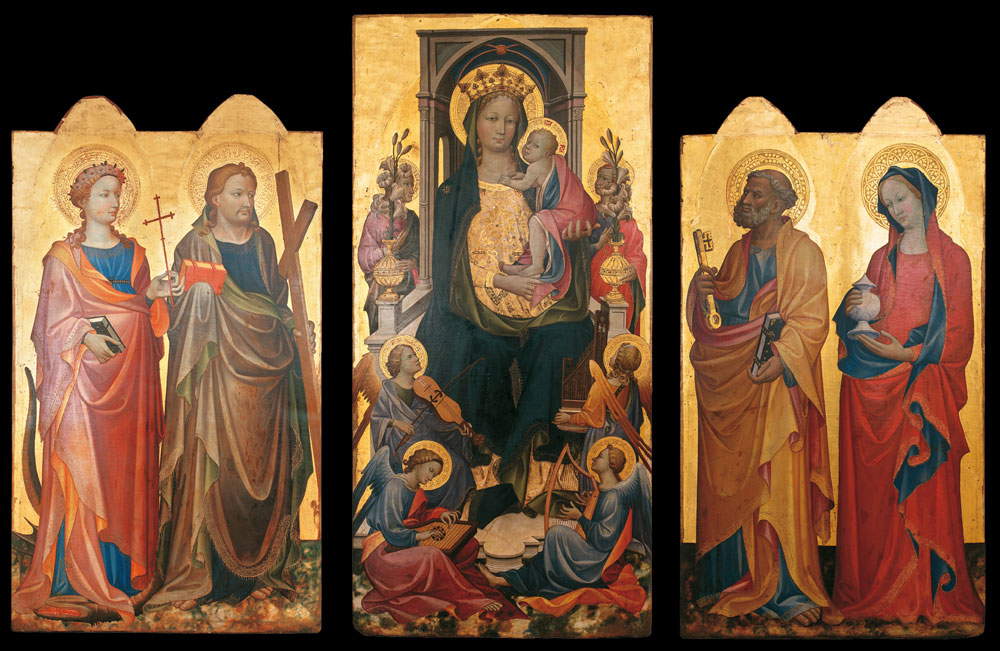 |
| Gherardo Starnina, Central compartment and side compartments of polyptych: St. Margaret of Antioch and St. Philip; Madonna and Child among Angels; St. Peter and St. Mary Magdalene (c. 1405; tempera on panel, central compartment: 161 x 77 cm, side compartments: 127 x 76 cm; Würzburg, Martin von Wagner Museum der Universität Würzburg) |
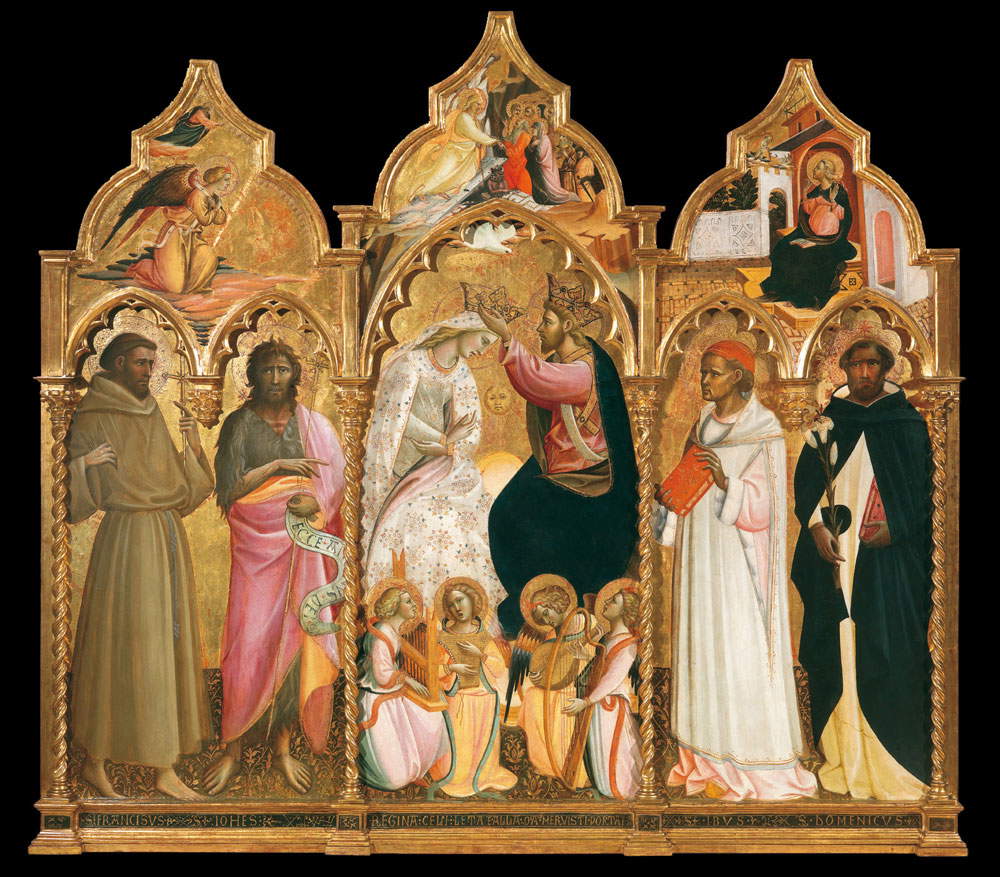 |
| Giovanni dal Ponte, Coronation of the Virgin and Saints (c. 1430; tempera on panel, 194 x 215.7 cm; Florence, Galleria dell’Accademia) |
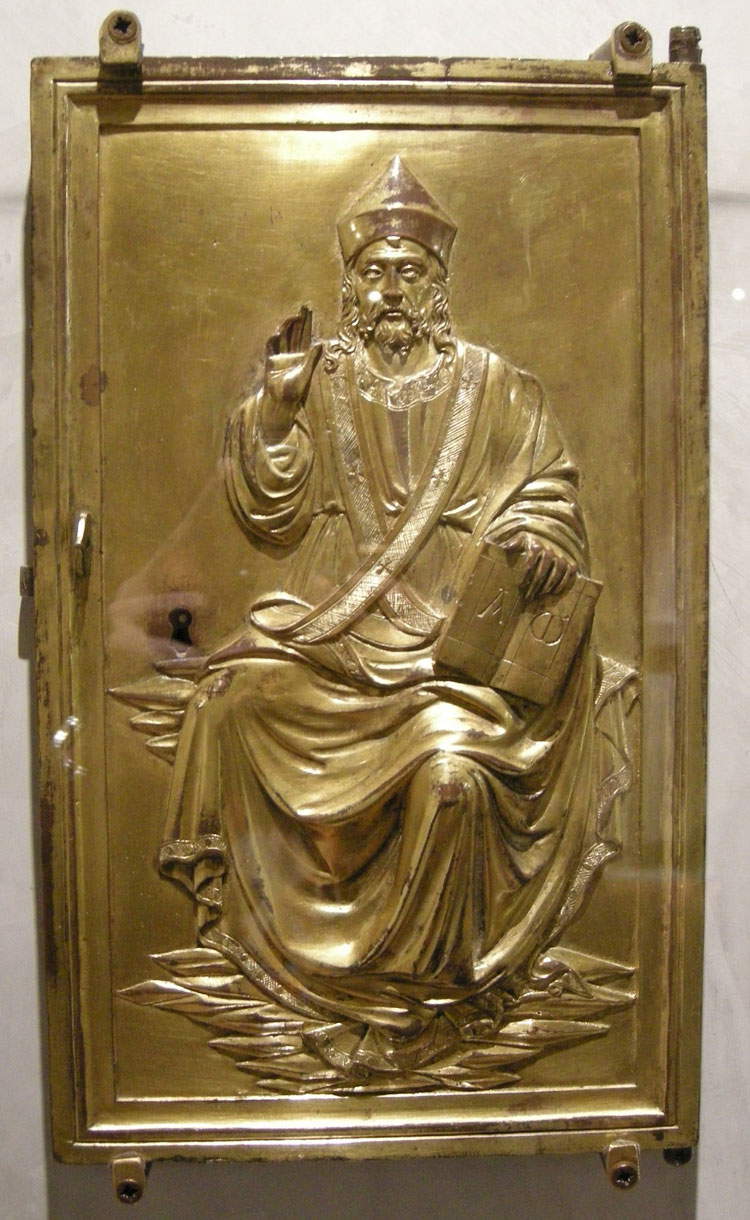 |
| Lorenzo Ghiberti, Christ Blessing (1450; gilded bronze, 35 x 22.3 cm; Florence, Arcispedale di Santa Maria Nuova). Credit |
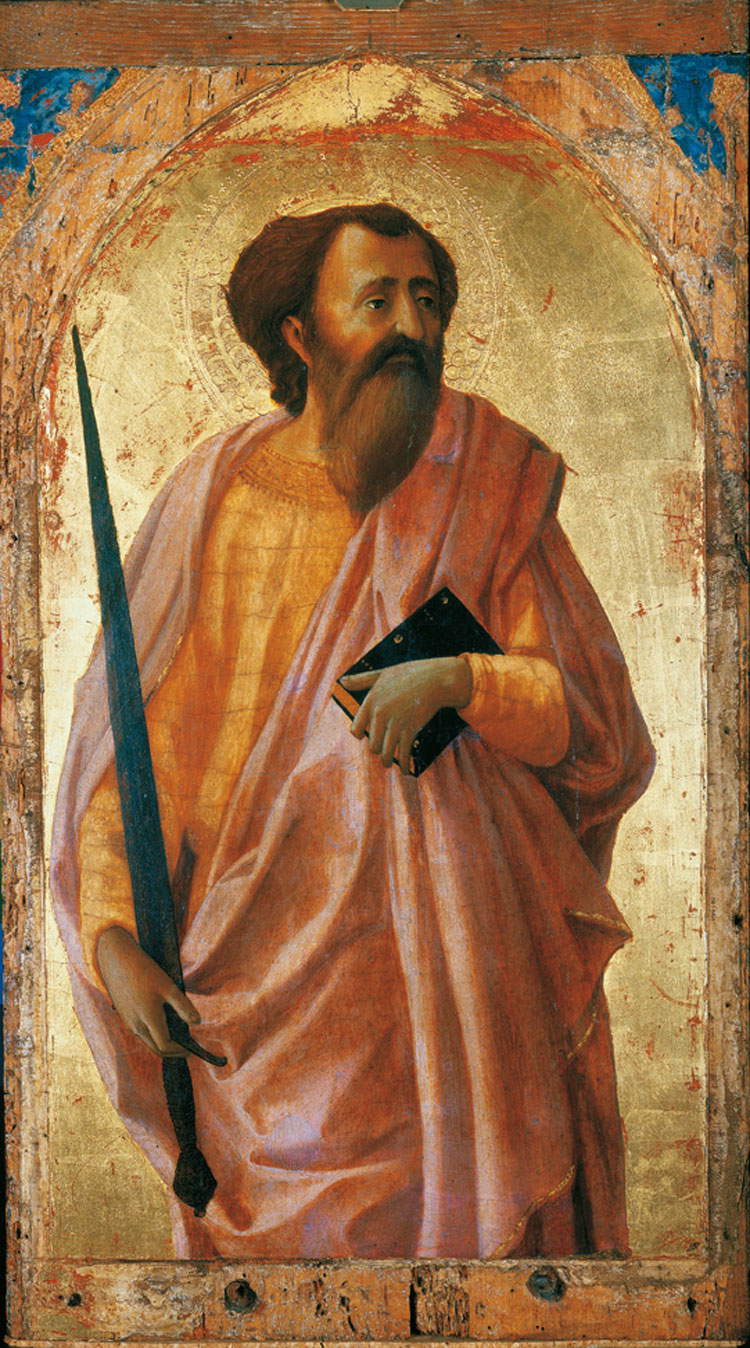 |
| Masaccio, Saint Paul (1426; tempera and oil on panel, 58.5 x 33.5 cm; Pisa, Museo Nazionale di San Matteo) |
The second room offers us a summary of Giovanni dal Ponte’s early experiences. On display are three works, referable to a period between 1405 and 1415: two Madonnas of Humility, one on loan from the Horne Museum in Florence, the other from the church of San Nicolò in Oltrarno, and the Triptych of Brozzi, currently at the Museum of San Donnino in Campi Bisenzio but formerly in the church of Sant’Andrea in Brozzi, also in the Campi Bisenzio area (the museum is housed in the complex adjacent to the church). The two Madonnas, painted around 1405-1410, show us how Giovanni dal Ponte’s very early training had taken place in a workshop still bound to the Giotto tradition: the figures are thus firmly established (though still somewhat uncertain), but they already allow themselves certain late Gothic “licenses” (the very long hand of the Madonna in the panel in the Horne Museum, for example) and denote from the outset that tenderness that never abandons the artist and which is especially observed in the attitudes of the Child, always intent on waving affectionately toward his mother, embracing her or kissing her face gently, or even holding a goldfinch that will be almost ubiquitous in paintings of this type. The triptych (an Annunciation with, in the side compartments, a highly refined Saint Eustace on the left and a serious Saint Anthony Abbot on the right), datable to c. 1410-1415, on the other hand, shows how the approach to late Gothic calligraphy was already fully accomplished: the vividness of Starnina’s work pervades the painting, St. Eustace is a splendid gentleman in elegant medieval garb (note the gauntlet with wide pointed lapels, which will return in other characters painted even decades later), hints of fluttering move the robes of Anthony Abbot, and the main scene, with the affected movements of the two protagonists, takes place above a very peculiar floor with decorations that seem to take the form of geometric solids and emerge from the painting.
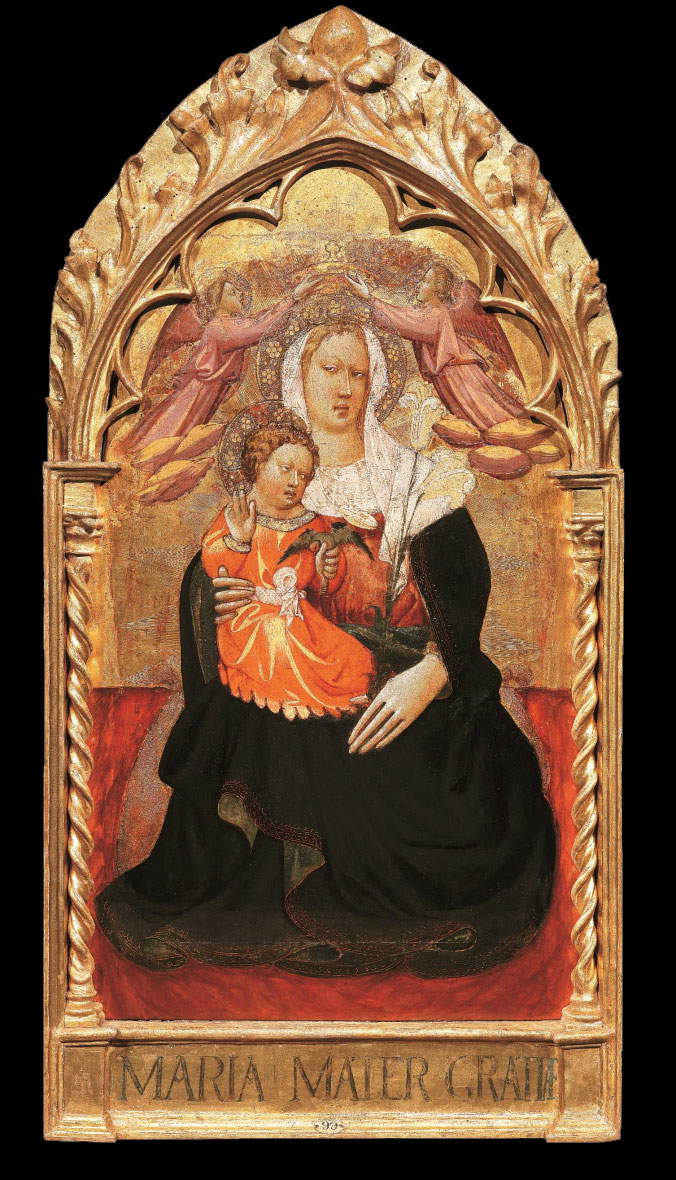 |
| Giovanni dal Ponte, Madonna and Child (c. 1405-1410; tempera on panel, 103 x 52 cm; Florence, Museo Horne) |
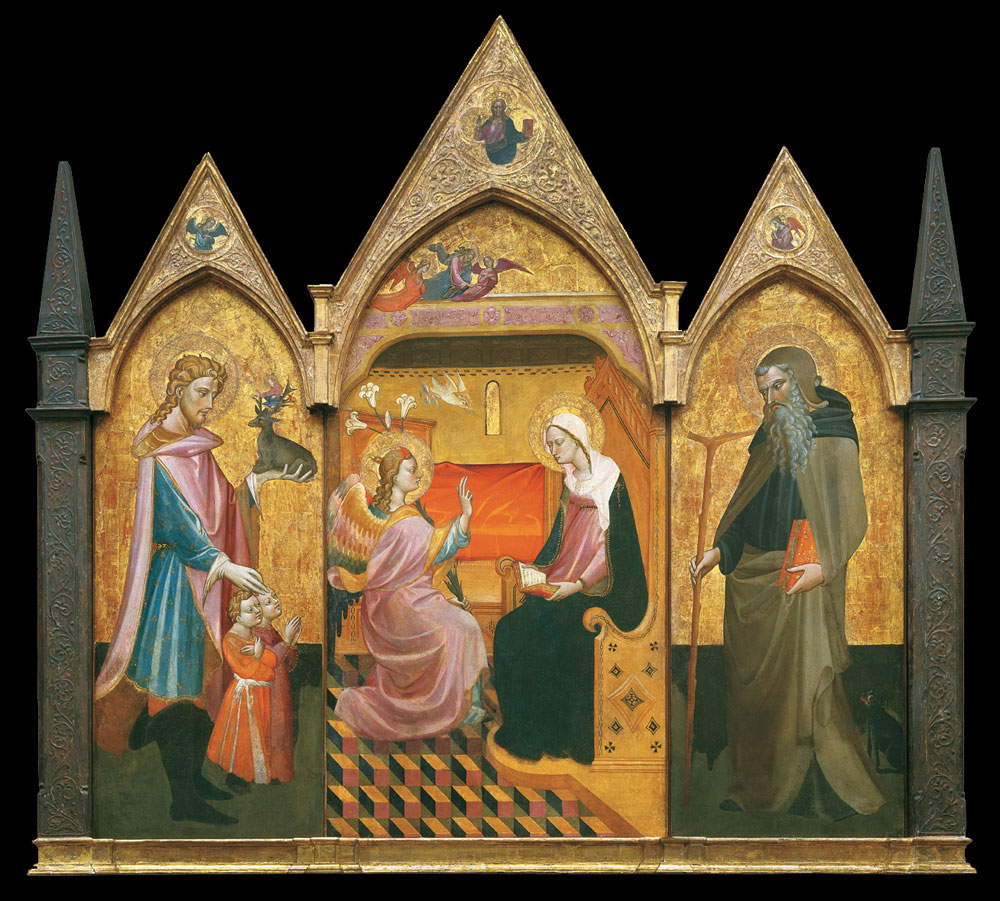 |
| Giovanni dal Ponte, Brozzi Triptych (c. 1410-1415; tempera on panel, 205 x 230 cm; Campi Bisenzio, Museo di Arte Sacra di San Donnino) |
The progressive approximation of Giovanni dal Ponte’s manner to Masaccio’s stylistic features is somewhat the leitmotif of the third room. Of particular relevance is a tablet that arrives from New Orleans: it is a Madonna and Child with Saints James the Greater and Anthony the Abbot, owned by the Rau Antiques gallery (it is for sale, by the way: if any of our institutions would like to come forward... ), where Giovanni dal Ponte, in addition to demonstrating a by now acquired familiarity with the suggestions derived from Gherardo Starnina’s personal reading of art, deepens his spatial investigations by giving the scene a new sense of depth obtained simply by advancing the figures of the two saints. We are now in the 1920s, and this new sensibility of the artist is confirmed by a work similar to the one in New Orleans, although quite clearly later, namely a Madonna and Child with Saints John the Baptist and Catherine of Alexandria, where the same spatial organization of the previous panel becomes decidedly more rational, and indicative of this are especially the two angels who no longer flutter in an indefinite space above the heads of the saints and beside the Madonna, but stand exactly behind the main characters, and their position is justified by the fact that they are stretching a veil behind the Virgin’s throne.
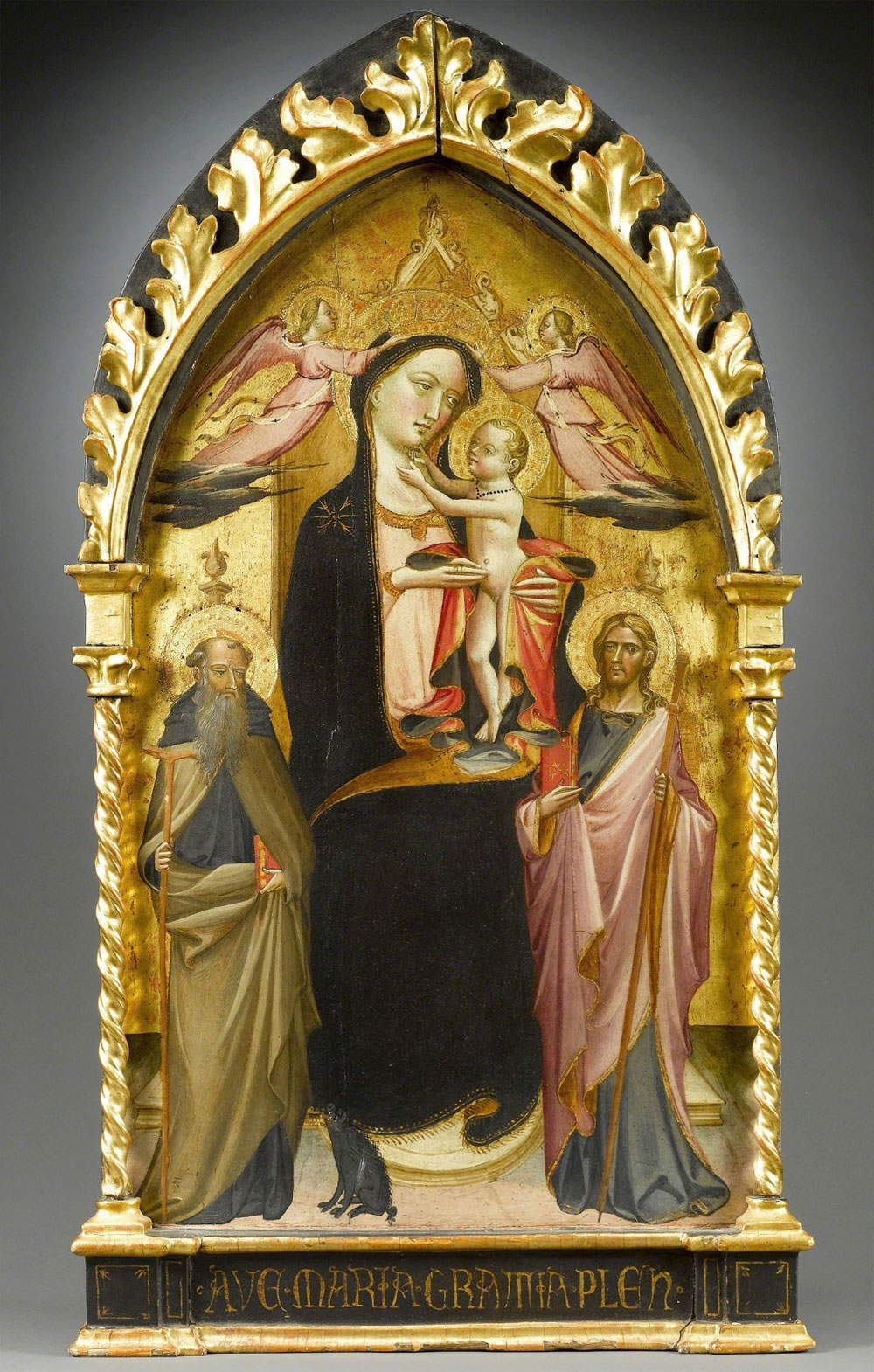 |
| Giovanni dal Ponte, Madonna and Child with Saints James the Greater and Anthony Abbot (c. 1420; tempera on panel, 54.6 x 35.6 cm; New Orleans, Rau Antiques) |
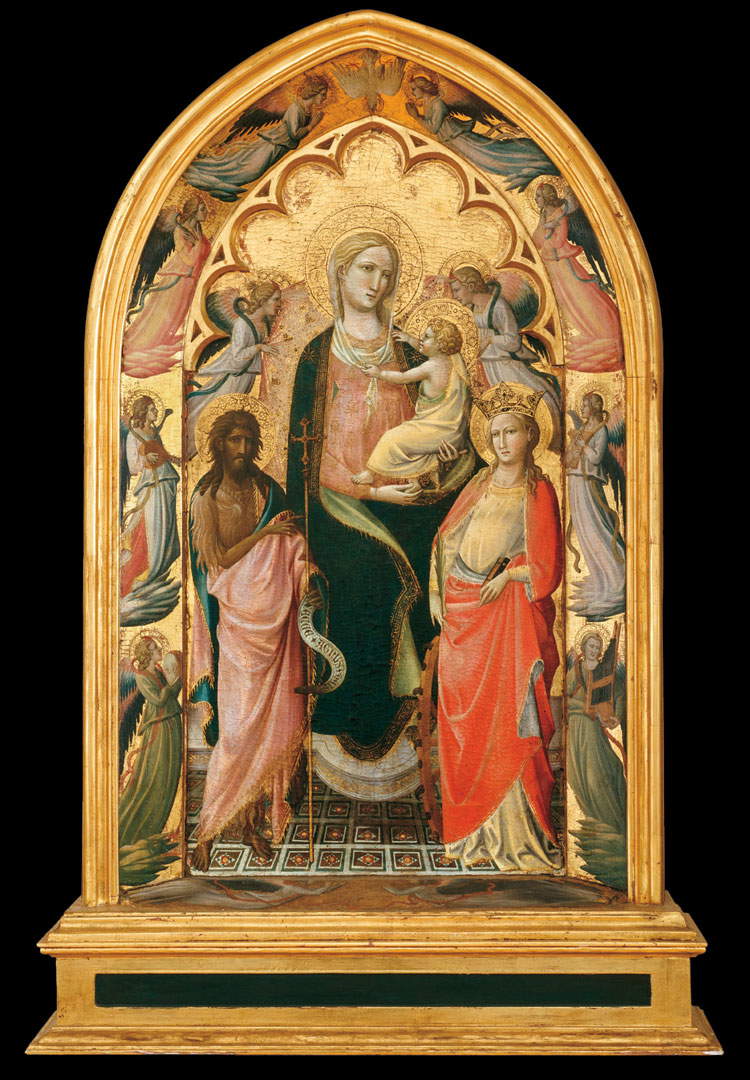 |
| Giovanni dal Ponte, Madonna and Child with Saints John the Baptist and Catherine of Alexandria (c. 1420; tempera on panel, 114.3 x 67.6 cm; Hartford, Wadsworth Atheneum Museum of Art) |
There is one particularly significant date: it is 1424, the year in which the artist was imprisoned for eight months because of debts, and when he came out, he was most likely thunderstruck by the work Masaccio was doing in the Brancacci Chapel, a few meters away from his workshop. Giovanni dal Ponte’s art thus veers toward a Masaccioism unprecedented in his art, and we see this very well if we compare the central compartment of the predella now at the Musées Royaux des Beaux-Arts in Brussels, which depicts theAdoration of the Magi, with the same episode painted by Masaccio in the predella of the Carmine Polyptych (not in the exhibition): in addition to the direct quotations (the Madonna-Child-Magus group bowing assumes poses identical to those of the same characters in Masaccio), we note how even the spatiality, in a composition that is moreover unusually uncrowded for Giovanni dal Ponte’s canons, a sign that his art is changing, the renewed plasticism (evident especially in the horseman holding in check the two horses on the right) and the study of movement are revealing of his in-depth reflection on Masaccio’s art. This reflection continues with the Polyptych of St. Peter, on whose dating the curators disagree: dated 1424 for Tartuferi, painted around 1430 for Sbaraglio. In the predella, now in the Uffizi, the vigor is still that deriving from Masaccio meditation, and the study of spatiality causes the lines of the two side compartments to converge toward the central one, but thecrowding of the scenes, the great excitement and the draperies that return to indulge in late Gothic viluces foreshadow what will be a return to the early days that will characterize the final phase of his career: when Giovanni dal Ponte, by now definitively moved away from Masaccism, will return to an art with a marked late Gothic imprint, in line with the taste of his patrons. Thelast known panel by Giovanni dal Ponte, dated November 1434 and placed at the close of the third room, already bears witness to this: it is the San Salvatore al Monte alle Croci Altarpiece, which, while abandoning the form of the polyptych to adopt that of the already Renaissance unitary altarpiece, again presents great crowding, elongated figures and sinuous drapery.
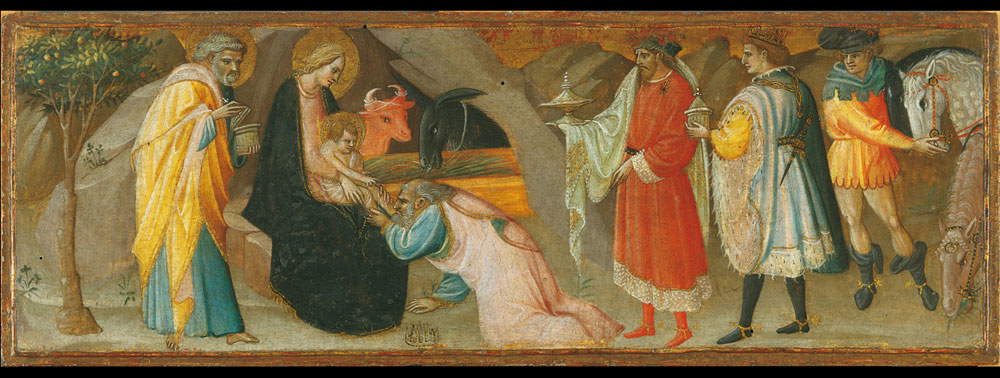 |
| Giovanni dal Ponte, Adoration of the Magi (c. 1425-1430, predella compartment; tempera on panel, 20 x 57.5 cm; Brussels, Musées Royaux des Beaux Arts de Belgique) |
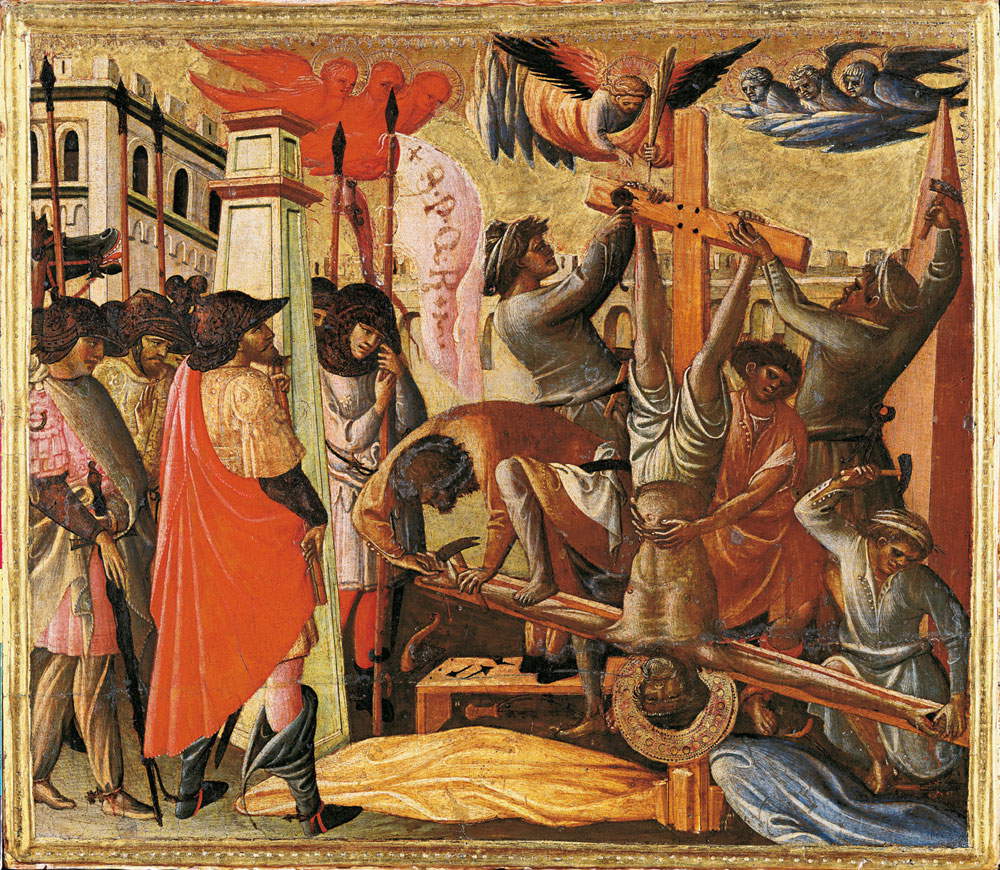 |
| Giovanni dal Ponte, Martyrdom of St. Peter (c. 1430, predella compartment; tempera on panel, 42.5 x 52 cm; Florence, Uffizi) |
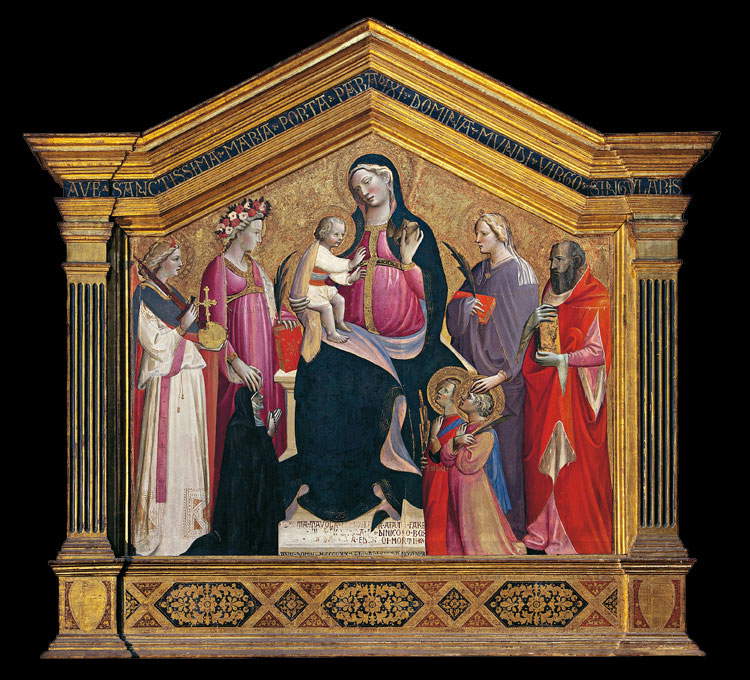 |
| Giovanni dal Ponte, Madonna and Child between Saints Cecilia with Donatrix, Michael the Archangel, Domitilla, Jerome, Achilleus, and Nereus (1434; tempera and gold on panel, 158 x 181 cm; Florence, San Salvatore al Monte alle Croci) |
The fourth and final section opens with a very interesting selection of secular-themed paintings, the only ones in the exhibition. Except for one case (a paper depicting a knight with swords) these are panels that decorated painted caissons, mostly dating from the last years of his activity, and revealing all the imagination of which our Giovanni dal Ponte was capable. The extraordinary nuptial caisson from the Musée Jacquemart-André in Paris, one of the rare examples in which not only the decorative panels but also the entire caisson have been preserved, which can be dated to c. 1430-1435, shows us a Garden of Love populated by pairs of lovers holding hands. On the iconology of this production by Giovanni dal Ponte we have an ongoing debate, because it is not clear what the lovers represent who, in the case of the Parisian painting, are heading toward the center of the composition: some scholars have tried to identify the couples with characters from history or mythology (the men’s fanciful headdresses, which display feathers, dragons, horns and assorted birds, would seem to be characterizing elements, insufficient, however, to formulate confident identifications); according to others, instead, they would be simple love allegories aimed at celebrating the union of the newlyweds. There is an important difference, also evident in the panels that have come down to us in fragments (on display, for example, is a beautiful Couple in Love from a private collection, with the very elegant knight wearing a hat adorned with an eagle and a pair of horns): in some panels it is the women who lead the men, while in others the opposite occurs, and this makes it possible to distinguish between the chests that were intended for the bride and those that were instead made for the groom. These are works of great pleasantness, which must have fully satisfied the expectations of the clientele and which show a clear recovery of late Gothic motifs. It is also worth mentioning theAllegory of the Seven Liberal Arts, another chest panel that perhaps constitutes one of the most obvious demonstrations of thatlate Gothic humanism included in the title of the exhibition: the seven arts move toward the center, where we see the allegory ofastronomy with Ptolemy at his feet, intent on writing one of his books, and each of them leads, holding one or more identifying attributes, an illustrious “exponent” of that art. Thus, from the left we find grammar (with Aelius Donatus or Priscianus), dialectic (Aristotle), rhetoric (Cicero), the aforementioned astronomy, then geometry (Euclid), arithmetic (Pythagoras), and music (Tubal-Cain, the mythical Bible blacksmith who invented musical instruments).
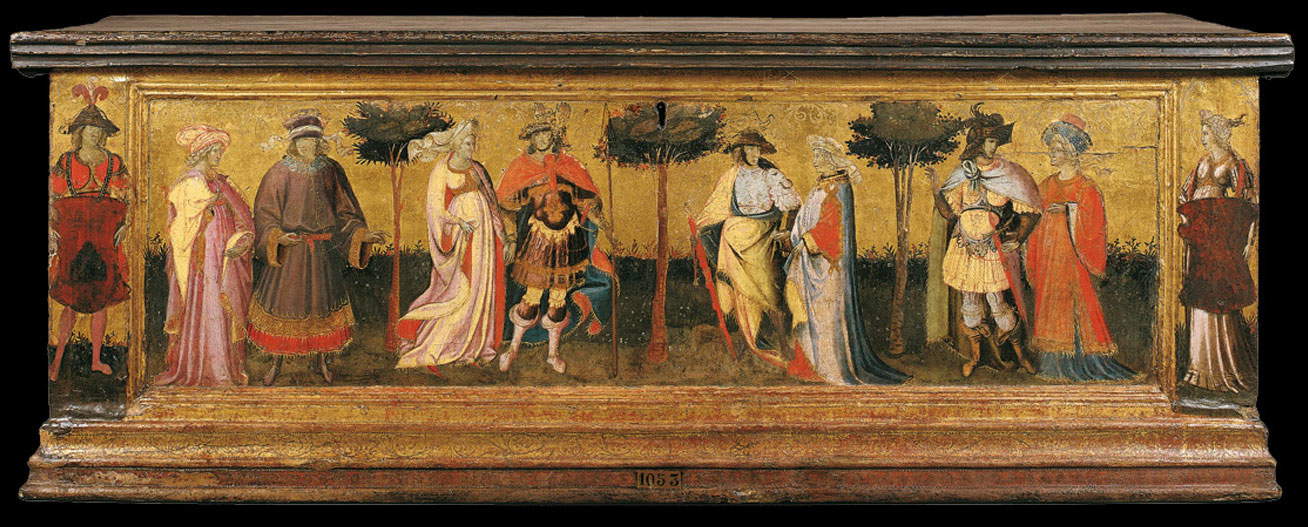 |
| Giovanni dal Ponte, Garden of Love (c. 1430-1435; tempera on panel, 67.6 x 175.4 x 59.1 cm; Paris, Musée Jacquemart-André) |
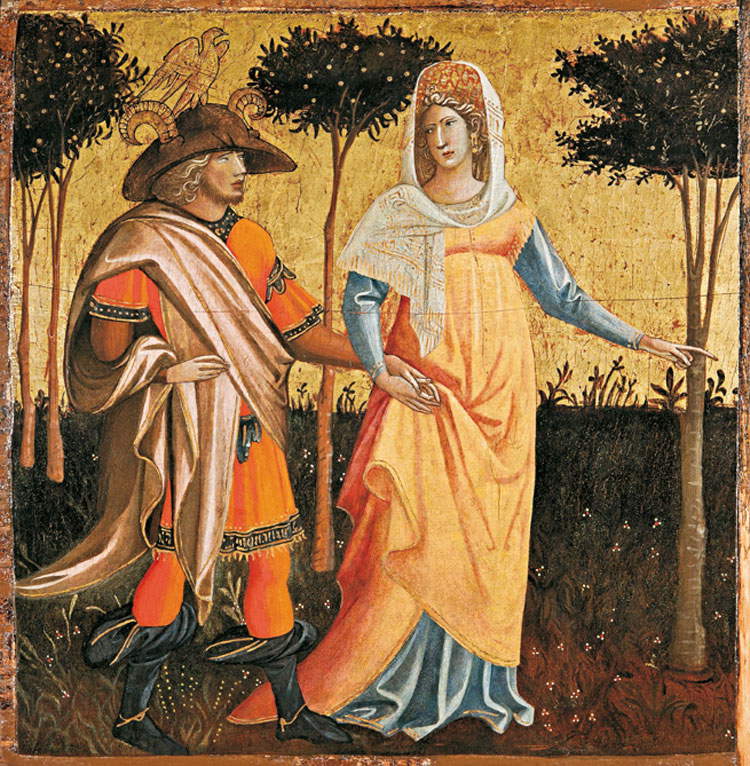 |
| Giovanni dal Ponte, Loving Couple (c. 1430; tempera on panel, 44.5 x 43 cm; Private collection) |
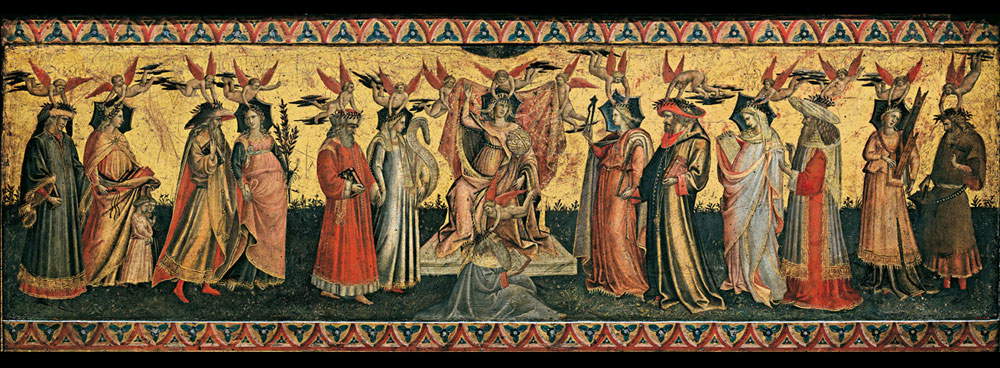 |
| Giovanni dal Ponte, Allegory of the Seven Liberal Arts (c. 1430-1435; tempera on panel, 45 x 155 cm; Paris, Madrid, Prado) |
The last works on display are those from the extreme phase of Giovanni dal Ponte’s production. As anticipated, late Gothic motifs return, which in some cases, however, are combined with experimentation unseen in the art of the exhibition’s protagonist: for example, in the splendid triptych of Poppiena the main scene, an Annunciation in which a very Gothic archangel Gabriel flutters on a small group of clouds in front of the Madonna addressing her the well-known greeting(Ave Maria gratia plena), which the painter renders with a blue ray furrowed by golden inscriptions, is set in a large portico that accommodates a sort of throne on which the Virgin sits. This is a solution that the exhibition visitor had already observed in theCoronation in the first room (which, in any case, is coeval with the group of paintings that we find in the final bars of the exhibition) and which returns in the Rosano triptych, dated 1434, where late Gothic reminiscences are still prominent: in the taste for decorativism, in the elongation of the figures and in certain interesting details (it is worth noting the Baby Jesus floating in the air above a cloud: again, it had already been seen in the contemporary Coronation). These are the last works in an exhibition that, even with its already described problems of communication, is definitely worth a visit and constitutes an important chapter in studies oflate Gothic art, particularly that which had to confront the dawn of the Renaissance.
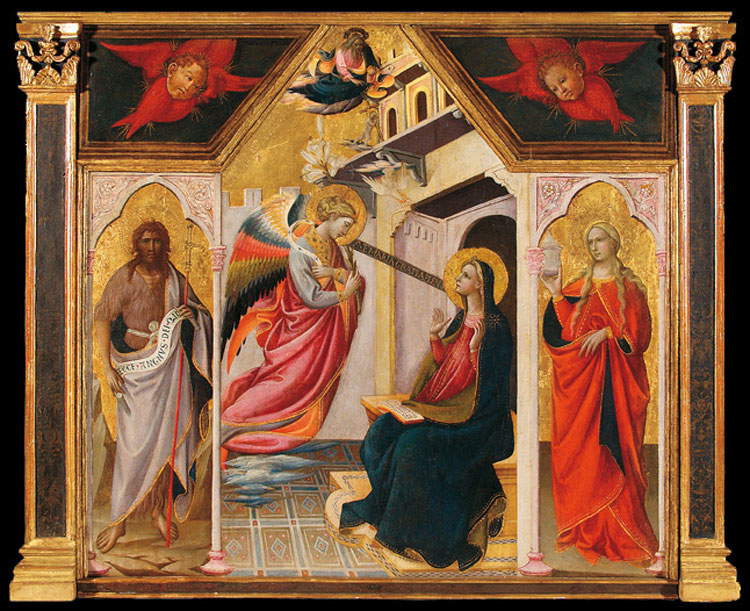 |
| Giovanni dal Ponte, Triptych of Poppiena (Late third to early fourth decade of the 15th century; tempera on panel, 150 x 182 cm; Pratovecchio-Stia, Badia di Santa Maria a Poppiena) |
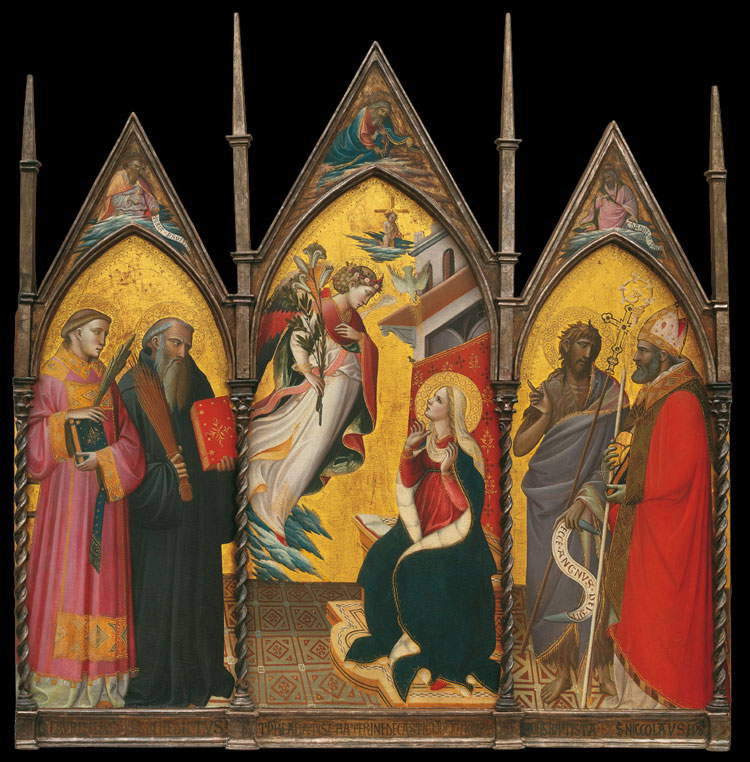 |
| Giovanni dal Ponte, Triptych of Rosano (1434; tempera on panel, 195 x 190.5 cm; Rosano, church of the abbey of Santa Maria) |
A note, finally, on the catalog, which I consider an almost undefined object. No one dares to question its scientificity and validity, but one wonders how valid is the choice to (I quote from the exhibition presentation by Cecilie Hollberg, Director of the Gallery) “innovate the catalog [...] with shorter texts, which, however, do not compromise the scientific rigor of which this museum has always been able to boast.” If the essays by the two curators, both on the developments of the painter’s style, can be considered more than acceptable (they are interesting and well documented), greater reservations can be expressed about the remaining three contributions (on the workshop, on the iconography of the Annunciations and on the musical iconography of Giovanni dal Ponte) and especially about the fact sheets, which are often so short and shallow as to border on superficiality. Suffice it to say that the card on theAllegory of the Liberal Arts is more concise than the one on the Prado Museum’s website (which, moreover, has a much richer bibliography than the one that accompanies the catalog card). Moreover, the presentation does not even give a reason that could substantiate the choice (and thus lead us, possibly, to agree with it), which is perceived as a decay on the level of quality: without going too far back in time, the catalog of the Carlo Portelli exhibition was a work of quite a different tenor. While the exhibition on Giovanni dal Ponte remains, as has already been reiterated, a review of undoubted depth and great importance, one wonders whether the critical factors (very poor dissemination capacity, catalog to be revised) do not represent the beginning of a risky road that could characterize the new course of the Accademia Gallery under the direction of Cecilie Hollberg and that, if it continues to be pursued, can only make one regret past management.
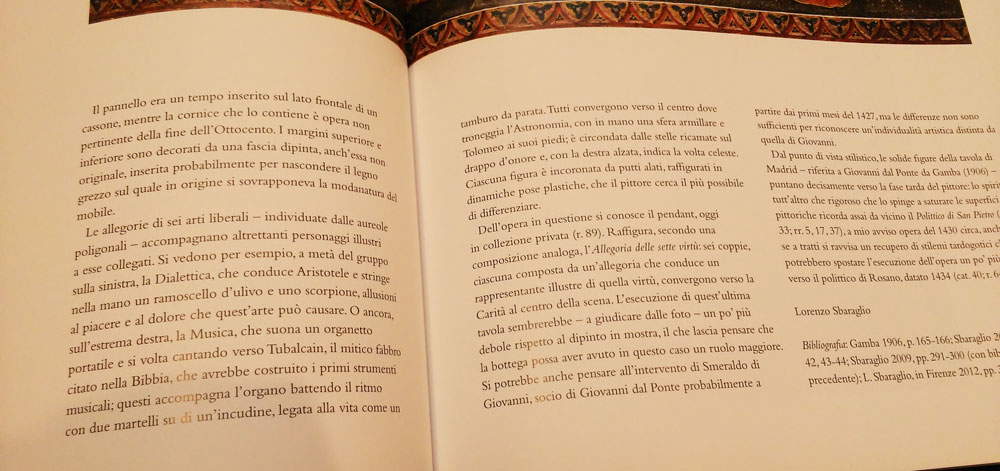 |
| The catalog card for the Allegory of the Seven Liberal Arts. |
Warning: the translation into English of the original Italian article was created using automatic tools.
We undertake to review all articles, but we do not guarantee the total absence of inaccuracies in the translation due to the program. You can
find the original by clicking on the ITA button. If you find any mistake,please contact us.
















































